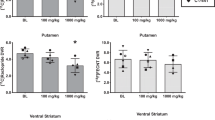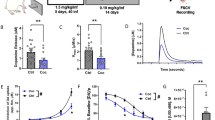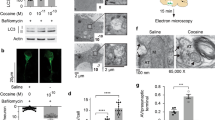Abstract
There are ∼1.6 million people who meet the criteria for cocaine addiction in the United States, and there are currently no FDA-approved pharmacotherapies. Amphetamine-based dopamine-releasing drugs have shown efficacy in reducing the motivation to self-administer cocaine and reducing intake in animals and humans. It is hypothesized that amphetamine acts as a replacement therapy for cocaine through elevation of extracellular dopamine levels. Using voltammetry in brain slices, we tested the ability of a single amphetamine infusion in vivo to modulate dopamine release, uptake kinetics, and cocaine potency in cocaine-naive animals and after a history of cocaine self-administration (1.5 mg/kg/infusion, fixed-ratio 1, 40 injections/day × 5 days). Dopamine kinetics were measured 1 and 24 h after amphetamine infusion (0.56 mg/kg, i.v.). Following cocaine self-administration, dopamine release, maximal rate of uptake (Vmax), and membrane-associated dopamine transporter (DAT) levels were reduced, and the DAT was less sensitive to cocaine. A single amphetamine infusion reduced Vmax and membrane DAT levels in cocaine-naive animals, but fully restored all aspects of dopamine terminal function in cocaine self-administering animals. Here, for the first time, we demonstrate pharmacologically induced, immediate rescue of deficits in dopamine nerve-terminal function in animals with a history of high-dose cocaine self-administration. This observation supports the notion that the DAT expression and function can be modulated on a rapid timescale and also suggests that the pharmacotherapeutic actions of amphetamine for cocaine addiction go beyond that of replacement therapy.
Similar content being viewed by others
Log in or create a free account to read this content
Gain free access to this article, as well as selected content from this journal and more on nature.com
or
References
Ahmed SH, Koob GF (1998). Transition from moderate to excessive drug intake: change in hedonic set point. Science 282: 298–300.
Ahmed SH, Lin D, Koob GF, Parsons LH (2003). Escalation of cocaine self-administration does not depend on altered cocaine-induced nucleus accumbens dopamine levels. J Neurochem 86: 102–113.
Beuming T, Kniazeff J, Bergmann ML, Shi L, Gracia L, Raniszewska K et al (2008). The binding sites for cocaine and dopamine in the dopamine transporter overlap. Nat Neurosci 11: 780–789.
Boudanova E, Navaroli DA, Melikian HE (2008). Amphetamine-induced decreases in dopamine transporter surface expression are protein kinase C-independent. Neuropharmacology 54: 605–612.
Calipari ES, Ferris MJ, Zimmer BA, Roberts DCS, Jones SR (2013a). Temporal pattern of cocaine intake determines tolerance vs sensitization of cocaine effects at the dopamine transporter. Neuropsychopharmacology 38: 2385–2392.
Calipari ES, Ferris MJ, Salahpour A, Caron MG, Jones SR (2013b). Methylphenidate amplifies the potency and reinforcing effects of amphetamines by increasing dopamine transporter expression. Nat Commun 4: 2720.
Calipari ES, Ferris MJ, Jones SR (2014a). Extended access of cocaine self-administration results in tolerance to the dopamine-elevating and locomotor-stimulating effects of cocaine. J Neurochem 128: 224–232.
Calipari ES, Ferris MJ, Melchior JR, Bermejo K, Salahpour A, Roberts DCS et al (2014b). Methylphenidate and cocaine self-administration produce distinct dopamine terminal alterations. Addict Biol 19: 145–155.
Calipari ES, Sun HG, Eldeeb K, Luessen DJ, Feng X, Howlett AC et al (2014c). Amphetamine self-administration attenuates dopamine D2 autoreceptor function. Neuropsychopharmacology 39: 1833–1842.
Chen NH, Reith MEA (2007). Substrates and inhibitors display different sensitivity to expression level of the dopamine transporter in heterologously expressing cells. J Neurochem 101: 377–388.
Chen NH, Reith MEA (2008). Substrates dissociate dopamine transporter oligomers. J Neurochem 105: 910–920.
Chen R, Tilley MR, Wei H, Zhou FW, Zhou FM, Ching S et al (2006). Abolished cocaine reward in mice with a cocaine-insensitive dopamine transporter. Proc Natl Acad Sci USA 103: 9333–9338.
Chiodo KA, Lack CM, Roberts DCS (2008). Cocaine self-administration reinforced on a progressive ratio schedule decreases with continuous D-amphetamine treatment in rats. Psychopharmacology 200: 465–473.
Czoty PW, Martelle JL, Nader MA (2010). Effects of chronic d-amphetamine administration on the reinforcing strength of cocaine in rhesus monkeys. Psychopharmacology 209: 375–382.
Czoty PW, Gould RW, Martelle JL, Nader MA (2011). Prolonged attenuation of the reinforcing strength of cocaine by chronic d-amphetamine in rhesus monkeys. Neuropsychopharmacology 36: 539–547.
Egana LA, Cuevas RA, Baust TB, Parra LA, Leak RK, Hochendoner S et al (2009). Physical and functional interaction between the dopamine transporter and the synaptic vesicle protein synaptogyrin-3. J Neurosci 29: 4592–4604.
Ferris MJ, Mateo Y, Roberts DCS, Jones SR (2011). Cocaine-insensitive dopamine transporters with intact substrate transport produced by self-administration. Biol Psychiatry 69: 201–207.
Ferris MJ, Calipari ES, Mateo Y, Melchior JR, Roberts DCS, Jones SR (2012). Cocaine self-administration produces pharmacodynamic tolerance: differential effects on the potency of dopamine transporter blockers, releasers, and methylphenidate. Neuropsychopharmacology 37: 1708–1716.
Ferris MJ, Calipari ES, Melchior JR, Roberts DCS, Espana RA, Jones SR (2013a). Paradoxical tolerance to cocaine after initial supersensitivity in drug-use-prone animals. Eur J Neurosci 38: 2628–2636.
Ferris MJ, Calipari ES, Yorgason JT, Jones SR (2013b). Examining the complex regulation and drug-induced plasticity of dopamine release and uptake using voltammetry in brain slices. ACS Chem Neurosci 4: 693–703.
Ferris MJ, Espana RA, Locke JL, Konstantopoulos JK, Rose JH, Chen R et al (2014). Dopamine transporters govern diurnal variation in extracellular dopamine tone. Proc Natl Acad Sci USA 111: E2751–E2759.
Fleckenstein AE, Metzger RR, Wilkins DG, Gibb JW, Hanson GR (1997). Rapid and reversible effects of methamphetamine on dopamine transporters. J Pharmacol Exp Ther 282: 834–838.
Fleckenstein AE, Haughey HM, Metzger RR, Kokoshka JM, Riddle EL, Hanson JE et al (1999). Differential effects of psychostimulants and related agents on dopaminergic and serotonergic transporter function. Eur J Pharmacol 382: 45–49.
Grabowski J, Rhoades H, Schmitz J, Stotts A, Daruzska LA, Creson D et al (2001). Dextroamphetamine for cocaine-dependence treatment: a double-blind randomized clinical trial. J Clin Psychopharmacol 21: 522–526.
Grabowski J, Shearer J, Merrill J, Negus SS (2004a). Agonist-like, replacement pharmacotherapy for stimulant abuse and dependence. Addict Behav 29: 1439–1464.
Grabowski J, Rhoades H, Stotts A, Cowan K, Kopecky C, Dougherty A et al (2004b). Agonist-like or antagonist-like treatment for cocaine dependence with methadone for heroin dependence: two double-blind randomized clinical trials. Neuropsychopharmacology 29: 969–981.
Hong WMC, Amara SG (2013). Differential targeting of the dopamine transporter to recycling or degradative pathways during amphetamine- or PKC-regulated endocytosis in dopamine neurons. FASEB J 27: 2995–3007.
Letchworth SR, Nader MA, Smith HR, Friedman DP, Porrino LJ (2001). Progression of changes in dopamine transporter binding site density as a result of cocaine self-administration in rhesus monkeys. J Neurosci 21: 2799–2807.
Little KY, Kirkman JA, Carroll FI, Clark TB, Duncan GE (1993). Cocaine use increases [H-3] Win-35428 binding-sites in human striatum. Brain Res 628: 17–25.
Malison RT, Best SE, van Dyck CH, McCance EF, Wallace EA, Laruelle M et al (1998). Elevated striatal dopamine transporters during acute cocaine abstinence as measured by [I-123]beta-CIT SPECT. Am J Psychiatry 155: 832–834.
Malison RT, Mechanic KY, Klummp H, Baldwin RM, Kosten TR, Seibyl JP et al (1999). Reduced amphetamine-stimulated dopamine release in cocaine addicts as measured by [I-123]IBZM SPECT. J Nucl Med 40: 110P.
Martinez D, Narendran R, Foltin RW, Slifstein M, Hwang DR, Broft A et al (2007). Amphetamine-induced dopamine release: markedly blunted in cocaine dependence and predictive of the choice to self-administer cocaine. Am J Psychiatry 164: 622–629.
Mateo Y, Lack CM, Morgan D, Roberts DCS, Jones SR (2005). Reduced dopamine terminal function and insensitivity to cocaine following cocaine binge self-administration and deprivation. Neuropsychopharmacology 30: 1455–1463.
Narendran R, Martinez D (2008). Cocaine abuse and sensitization of striatal dopamine transmission: A critical review of the preclinical and clinical imaging literature. Synapse 62: 851–869.
Negus SS, Mello NK (2003a). Effects of chronic d-amphetamine treatment on cocaine- and food-maintained responding under a progressive-ratio schedule in rhesus monkeys. Psychopharmacology 167: 324–332.
Negus SS, Mello NK (2003b). Effects of chronic d-amphetamine treatment on cocaine- and food-maintained responding under a second-order schedule in rhesus. Drug Alcohol Dependence 70: 39–52.
Negus SS (2003). Rapid assessment of choice between cocaine and food in rhesus monkeys: Effects of environmental manipulations and treatment with d-amphetamine and flupenthixol. Neuropsychopharmacology 28: 919–931.
Norman AB, Tabet MR, Norman MK, Tsibulksy VL (2014). Maintained cocaine self-administration is determined by quantal responses: implications for the measurement of antagonist potency. J Pharmacol Exp Ther 348: 311–315.
Oleson EB, Talluri S, Childers SR, Smith JE, Roberts DCS, Bonin KD et al (2009). Dopamine uptake changes associated with cocaine self-administration. Neuropsychopharmacology 34: 1174–1184.
O'Neill B, Tilley MR, Han DD, Thirtamara-Rajamani K, Hill ER, Bishop GA et al (2014). Behavior of knock-in mice with a cocaine-insensitive dopamine transporter after virogenetic restoration of cocaine sensitivity in the striatum. Neuropharmacology 79: 626–633.
Richards TL, Zahniser NR (2009). Rapid substrate-induced down-regulation in function and surface localization of dopamine transporters: rat dorsal striatum versus nucleus accumbens. J Neurochem 108: 1575–1584.
Richardson NR, Roberts DCS (1996). Progressive ratio schedules in drug self-administration studies in rats: a method to evaluate reinforcing efficacy. J Neurosci Methods 66: 1–11.
Rothman RB, Blough BE, Baumann MH (2006). Dual dopamine-5-HT releasers: potential treatment agents for cocaine addiction. Trends Pharmacol Sci 27: 612–618.
Rothman RB, Blough BE, Baumann MH (2008). Dopamine/serotonin releasers as medications for stimulant addictions. Prog Brain Res 172: 385–406.
Rush CR, Stoops WW (2012). Agonist replacement therapy for cocaine dependence: a translational review. Future Med Chem 4: 245–265.
Saunders C, Ferrer JV, Shi L, Chen JY, Merrill G, Lamb ME et al (2000). Amphetamine-induced loss of human dopamine transporter activity: an internalization-dependent and cocaine-sensitive mechanism. Proc Natl Acad Sci USA 97: 6850–6855.
Sitte HH, Farhan H, Javitch JA (2004). Oligomerization as a determinant of transporter function and trafficking. Mol Interv 4: 38–47.
Substance Abuse and Mental Health Services Administration (SAMHSA) (2008) National Survey on Drug Use and Health Available at http://oas.samhsa.gov/nhsda.htm.
Suto N, Ecke LE, Wise RA (2009). Control of within-binge cocaine-seeking by dopamine and glutamate in the core of nucleus accumbens. Psychopharmacology 205: 431–439.
Suto N, Wise RA (2011). Satiating Effects of Cocaine Are Controlled by Dopamine Actions in the Nucleus Accumbens Core. J Neurosci 31: 17917–17922.
Tilley MR, O'Neill B, Han DD, Gu HH (2009). Cocaine does not produce reward in absence of dopamine transporter inhibition. Neuroreport 20: 9–12.
Volkow ND, Wang GJ, Fowler JS, Logan J, Hitzemann R, Gatley SJ et al (1996a). Cocaine uptake is decreased in the brain of detoxified cocaine abusers. Neuropsychopharmacology 14: 159–168.
Volkow ND, Wang GJ, Fowler JS, Gatley SJ, Ding YS, Logan J et al (1996b). Relationship between psychostimulant-induced ''high'' and dopamine transporter occupancy. Proc Natl Acad Sci USA 93: 10388–10392.
Volkow ND, Wang GJ, Fowler JS, Logan J, Gatley SJ, Hitzemann R et al (1997). Decreased striatal dopaminergic responsiveness in detoxified cocaine-dependent subjects. Nature 386: 830–833.
Willuhn I, Burgeno LM, Groblewski PA, Phillips PEM (2014). Excessive cocaine use results from decreased phasic dopamine signaling in the striatum. Nat Neurosci 17: 704–709.
Yorgason JT, Espana RA, Jones SR (2011). Demon Voltammetry and Analysis software: analysis of cocaine-induced alterations in dopamine signaling using multiple kinetic measures. J Neurosci Methods 202: 158–164.
Zernig G, Ahmed SH, Cardinal RN, Morgan D, Acquas E, Foltin RW et al (2007). Explaining the escalation of drug use in substance dependence: models and appropriate laboratory tests. Pharmacology 80: 65–119.
Zimmer BA, Dobrin CV, Roberts DCS (2011). Brain-cocaine concentrations determine the dose self-administered by rats on a novel behaviorally dependent dosing schedule. Neuropsychopharmacology 36: 2741–2749.
Zimmer BA, Dobrin CV, Roberts DCS (2013). Examination of behavioral strategies regulating cocaine intake in rats. Psychopharmacology 225: 935–944.
Zimmer BA, Chiodo KA, Roberts DCS (2014). Reduction of the reinforcing effectiveness of cocaine by continuous D-amphetamine treatment in rats: importance of active self-administration during treatment period. Psychopharmacology 231: 949–954.
Acknowledgements
This work was funded by NIH grants R01 DA021325, R01 DA030161, R01 DA014030 (to SRJ), K99 DA031791 (to MJF), T32 DA007246 (to MJF and ESC), F31 DA031533 (to ESC), F31 DA037710, T32 AA007565 (to CAS), and F31 DA035558 (to JHR).
Author information
Authors and Affiliations
Corresponding author
Additional information
Supplementary Information accompanies the paper on the Neuropsychopharmacology website
Supplementary information
Rights and permissions
About this article
Cite this article
Ferris, M., Calipari, E., Rose, J. et al. A Single Amphetamine Infusion Reverses Deficits in Dopamine Nerve-Terminal Function Caused by a History of Cocaine Self-Administration. Neuropsychopharmacol 40, 1826–1836 (2015). https://doi.org/10.1038/npp.2015.45
Received:
Revised:
Accepted:
Published:
Issue date:
DOI: https://doi.org/10.1038/npp.2015.45
This article is cited by
-
Astrocytes modulate cerebral blood flow and neuronal response to cocaine in prefrontal cortex
Molecular Psychiatry (2024)
-
Glucagon-like peptide 1 receptor activation regulates cocaine actions and dopamine homeostasis in the lateral septum by decreasing arachidonic acid levels
Translational Psychiatry (2016)
-
Adolescent d-amphetamine treatment in a rodent model of attention deficit/hyperactivity disorder: impact on cocaine abuse vulnerability in adulthood
Psychopharmacology (2016)



